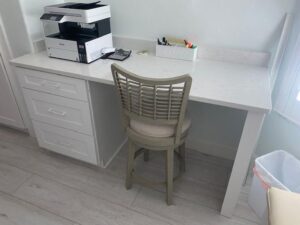Definition of Plywood
Plywood is a type of manufactured wood panel that is made by gluing together thin sheets or “plies” of wood veneer. These plies are stacked in alternating grain patterns, which gives plywood its unique strength and durability compared to solid wood. The number of plies can vary, affecting the thickness and strength of the plywood.
Brief History
Plywood has been used for centuries, with early examples dating back to ancient Egypt, where thin layers of wood were glued together to create strong and flexible materials. However, modern plywood as we know it today began to take shape in the 20th century with the advent of industrial production methods. Plywood has since become an essential material in various industries, particularly in construction and furniture making.
Different Types
There are several types of plywood, each designed for specific applications:
- Softwood Plywood: Typically made from softwoods like pine or fir, this type is commonly used in construction for roofing, walls, and flooring.
- Hardwood Plywood: Made from hardwood species such as oak, maple, or birch, this type is often used for furniture and cabinetry where appearance and durability are crucial.
- Marine Plywood: Designed to resist moisture, this type is used in boat building and other applications where the wood is exposed to water.
Properties of Plywood
Strength and Durability
One of the primary advantages of plywood is its high strength-to-weight ratio. The cross-grain structure of plywood distributes weight more evenly across the board, making it stronger than many other wood products of similar thickness. This property makes plywood an excellent choice for structural applications in construction.
Versatility
Plywood is incredibly versatile, making it suitable for a wide range of applications, from home construction to furniture making. It can be cut, shaped, and finished in various ways, allowing for creative and functional designs.
Resistance to Cracking, Shrinking, and Warping
The layered structure of plywood gives it resistance to cracking, shrinking, and warping. Unlike solid wood, which can twist and warp over time due to changes in moisture content, plywood remains stable, making it a reliable material for long-term use.
Plywood in Construction
Common Uses
In the construction industry, plywood is used in a variety of ways:
- Walls and Roofs: Plywood sheets are often used as a base layer for walls and roofs, providing a strong, stable surface for further construction.
- Flooring: Plywood is used as subflooring beneath carpets, hardwood, or tile, offering a smooth and level surface.
- Furniture and Cabinetry: Plywood is a popular choice for building cabinets, shelves, and other furniture due to its strength and ease of use.
Benefits
- Cost-Effectiveness: Plywood is generally less expensive than solid wood, making it a cost-effective choice for many construction projects.
- Ease of Use: Plywood can be easily cut into different shapes and sizes, making it a flexible material for a variety of applications.
- Environmental Sustainability: Plywood production uses less timber than traditional solid wood boards, making it a more sustainable option.

The Importance of Quality Cabinets: Spotlight on Cabinet Zone
Cabinet Zone: Your Source for Quality Cabinets
When it comes to home construction and renovation, particularly in areas like kitchens and bathrooms, the quality of cabinets is paramount. Cabinet Zone is a leading website that offers a wide range of high-quality plywood cabinets designed to enhance both the functionality and aesthetic appeal of your home. The importance of using quality plywood in cabinets cannot be overstated, as it ensures durability, longevity, and a polished appearance that adds value to your space.
How Plywood Relates to Quality Cabinets
Plywood is an excellent material for cabinet construction due to its strength, versatility, and resistance to warping. Cabinets made from high-quality plywood, like those offered by Cabinet Zone, provide a durable storage solution that withstands the daily wear and tear of kitchen and bathroom environments. By choosing quality plywood cabinets, you invest in a long-lasting product that will maintain its beauty and functionality for years to come.
Process of Plywood Construction
Selection and Preparation
The construction process begins with the selection of the appropriate type of plywood based on the intended use. The plywood is then cut into the desired shapes and sizes using precision tools.
Joining and Assembly
Plywood pieces are joined together using adhesives, screws, or nails, depending on the specific application. For cabinets and furniture, careful assembly is crucial to ensure stability and strength.
Finishing
The final step involves sanding the surfaces to create a smooth finish, followed by the application of sealants, paint, or varnish to protect the plywood and enhance its appearance.
Safety Measures in Plywood Construction
Proper Handling and Storage
To prevent damage, plywood should be handled with care and stored in a dry, flat location to avoid warping. When working with plywood, especially during cutting or sanding, it’s essential to wear protective gear, such as gloves, safety glasses, and masks, to protect against dust and fumes.
Addressing Moisture Issues
One of the challenges in using plywood is its susceptibility to moisture damage, which can lead to swelling or warping. To mitigate this, it is important to seal the plywood properly, especially in areas exposed to moisture. Regular maintenance, such as reapplying sealants, can also help prolong the life of plywood in damp environments.
Future Trends in Plywood Construction
Technological Advancements
The plywood industry is increasingly embracing technological advancements such as automation, robotics, and AI to improve the efficiency and precision of plywood production. These innovations are expected to lead to better quality products and more sustainable manufacturing processes.
Sustainable Practices
As environmental concerns grow, the plywood industry is shifting towards more sustainable practices, such as using eco-friendly adhesives and sourcing timber from responsibly managed forests. This focus on sustainability is becoming a key trend in the market, driven by consumer demand for greener products.
Conclusion
Plywood is a versatile, cost-effective, and sustainable material that plays a crucial role in the construction industry. Its unique properties make it ideal for a wide range of applications, from structural components to furniture and cabinetry. By choosing high-quality plywood, such as the products offered by Cabinet Zone, homeowners can ensure their cabinets and other plywood-based furnishings will be durable, attractive, and long-lasting.
FAQ Section
- What are some common uses for plywood in construction?
Plywood is commonly used for walls, roofs, flooring, furniture, and cabinetry. - Why is plywood considered a cost-effective material?
Plywood is less expensive than solid wood and uses less timber, making it a cost-effective and environmentally sustainable option. - How can I ensure my safety when using tools to cut or shape plywood?
Always wear protective gear, such as gloves, safety glasses, and masks, and ensure proper handling and storage of plywood to prevent accidents and damage.



